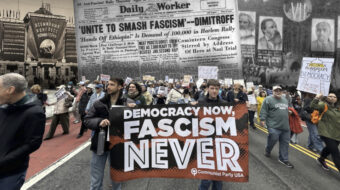Slightly over a year ago, the American people elected a young African American to the presidency and increased the Democratic majorities in the Congress. President Obama’s victory represented a repudiation of the right-wing ideology, politics and economics. It constituted a serious setback for neoliberalism in both its conservative and liberal skin.
The defeat of right-wing extremism was a long time in coming, but when it finally happened it did so not only because of the brilliance of the candidate, now president, but also due to the broad wings of a people’s coalition. Not in our lifetime have we participated in such a movement.
This swing in the political pendulum in the direction of economic justice, equality and peace ushered in the possibility of a new era. After 30 years of right-wing dominance, the balance of class and social forces is tilting once again in a progressive direction, but not to the degree that a people’s agenda is simply rolled out and easily enacted.
That would be wishful thinking and we shouldn’t engage in such thinking, as tempting as it is. The struggle ahead, much like the struggle over the past three decades, will be fierce. There will be no easy victories. But political advantage has shifted to our side and that’s no small accomplishment.
To turn this advantage into a new New Deal will take many things, but two I consider fundamental: a proper strategy and a sense of process.
Some may wonder why I don’t mention tactics. They are important to be sure, but they are shaped by strategy and process, not the other way around. Tactics are a dependent variable in this equation.
A proper strategy envisions the main class and social groupings and personalities that have to be assembled and united to transform the possibility of this moment into a concrete, lived reality for millions of people.
The strategic thrust of last year – to defeat the ultra right, especially as expressed by the Republican Party, at the polls – doesn’t quite fill the bill any longer. Right wing extremism is still a factor, as demonstrated by the health care battle, but as a result of the election’s outcome, it is on the defensive, no longer able to set the agenda and frame the debate to its desire.
At the same time a pure anti-corporate strategy doesn’t quite fit either, given the configuration of forces coming out of the elections and the political agenda going forward.
The coalition to deepen and consolidate the promise of our time, in my view, stretches (for now) from President Obama to the core forces of the people’s movement: labor, African American, Latino, and other the racially oppressed people, women, and youth. It also includes those who sat out last year’s election, small and medium sized businesses, dissatisfied grassroots supporters of the right wing, sections of the Democratic Party and even corporate capital – depending on the issue at hand.
So the task – and it won’t be easy – is to activate and maximize the unity of this very diverse, multi-class, and fluid coalition in the course of concrete struggles.
There will be competing views. Not everyone will be on board on every issue; the lineup and mix will change as the agenda and struggle changes. Some participants will be dependable and clear headed – the core forces – while others will be unreliable and temporary.
The notion of the capitalist class on the one side and the working class on the other may sound “radical,” but it is neither Marxist, nor found in life and politics. Pure forms exist in high theory, but nowhere else. It would be a profound mistake to distance the core forces of this coalition from others who are temporary and unreliable at this and subsequent stages of struggle.
As for process, it is imperative to have a sense of the ebbs and flows of mass struggle – the contradictions and the dialectics – plus the near constant reconfiguration of this broad, multi-class coalition. Progress (and process) is never a straight line forward nor neatly packaged. It is usually ragged.
The main elements of the New Deal, for instance, were won not in 1933, which was Roosevelt’s first year in office, but in 1935-1937. These elements were the fruit of a many-layered, multi-faceted struggle of a motley group of social actors.
I suspect the future will be much the same.










